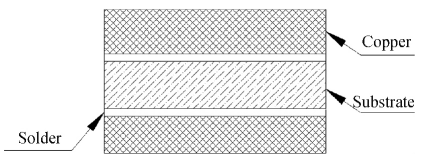Abstract: the excellent high reliability of silicon nitride ceramic copper-clad substrate makes it one of the most promising substrate materials for power modules in high-speed rail, electric vehicles and other fields. At present, only Japanese manufacturers have mass production capacity, and it is difficult to import domestically, which hinders the development of related industries. High performance silicon nitride ceramic substrate was prepared by air pressure sintering, and silicon nitride ceramic copper-clad substrate was obtained by active metal brazing process. The bending strength of silicon nitride ceramics is 800 MPa and the fracture toughness is 8 0 MPa·m ½, Thermal conductivity 90 w / (m · K), AC breakdown strength 40 kV / mm and volume resistivity 3 seven × 1014 Ω·cm; The peel strength of silicon nitride ceramic copper-clad substrate reaches 130 n / cm. Under the high and low temperature cyclic impact of - 45 ~ 150 ℃, the impact times of silicon nitride ceramic copper-clad substrate are 10 times and 100 times that of aluminum nitride and alumina copper-clad substrate respectively; In copper thickness 0 32 mm/0. 25 mm impact times up to 5000 times and copper thickness of 0.5 mm 5 mm/0. When the impact times of 5 mm reach 1000 times, the samples are intact; In copper thickness 0 8 mm/0. When the impact times of 8 mm reached 500 times, the sample still did not produce microcracks and other defects, which was different from the copper thickness of 0.5 mm 32 mm/0. The cycle times of aluminum nitride copper clad substrate are the same at 25 mm; The reliability of silicon nitride ceramic copper-clad substrate is obviously better than that of existing products.
Keywords: silicon nitride ceramics; Copper clad substrate; Active metal brazing; Reliability; power device
0 Introduction
In order to solve the increasingly serious environmental problems, electric power as a clean energy has become the focus of attention all over the world, and the electrification of energy utilization has become the direction of development. In the application of electric power, high-power power electronic devices (such as insulated gate bipolar transistor IGBT) are the core to realize energy control and conversion. They are widely used in the fields of high-speed railway, smart grid, electric vehicle and new energy equipment [1-2]. With the increase of energy density, power devices have higher and higher requirements for heat dissipation capacity and reliability of ceramic copper-clad substrate. At present, the materials of ceramic copper-clad substrates for power devices mainly include alumina (Al2O3), aluminum nitride (AlN) and silicon nitride (Si3N4) [3-4]. Al2O3 copper-clad substrate is mainly prepared by direct bonded copper (DBC) [5-6]. It has low thermal conductivity and limited heat dissipation capacity. It is mostly used in fields with low power density and no strict requirements for reliability. AlN copper clad substrate mainly adopts the active metal brazing (AMB) process with higher reliability. Due to the high heat dissipation capacity of aluminum nitride AMB copper clad substrate (AlN AMB Cu), it is suitable for some working environments with high power and high current. However, due to the relatively low mechanical strength, the high and low temperature cyclic impact life of AlN AMB Cu is limited, Its application scope is limited. On the other hand, with the maturity of the preparation technology of the third generation power chips (such as SiC and GaN) [7-8], higher power density and higher working ambient temperature lead to the rapid decline of high and low temperature cycle impact times and reliability of Al2O3 and AlN copper-clad substrates, which can not meet the use requirements. Silicon nitride AMB copper clad substrate (Si3N4 - AMB Cu) has become one of the more promising candidate materials because of its excellent comprehensive thermodynamic properties of high strength, high toughness, high temperature resistance and high reliability [9-12]. Si3N4 - AMB Cu not only has the same heat dissipation capacity as AlN, but also its service life can be increased by more than one order of magnitude. Miyazakia et al. [13] studied the cyclic impact properties of Si3N4 AMB Cu at - 40 ~ 250 ℃: after 100 cycles, the copper thickness was 0.5 mm Microcracks occurred in the ceramic in the 3 mm sample, while the thickness of copper was 0.5 mm The 15 mm sample did not produce microcracks after 1000 cycles. In fact, Si3N4 AMB Cu has been used in some models of Toyota and Tesla. However, at present, the preparation technology of high-performance Si3N4 ceramic substrate is mainly in the hands of Japanese companies, and there is no mass production capacity in China. Therefore, there are few reports on the research of Si3N4 AMB Cu. Based on the development of high-performance Si3N4 ceramic substrate, this paper carries out the research on the reliability evaluation of Si3N4 AMB Cu, so as to accumulate basic experimental data for the wide application of corresponding power devices in China’s high-speed railway, smart grid, electric vehicle and other fields.
Experiment
1.1 experimental raw materials and instruments
Raw materials: Si3N4 ceramic substrate, oxygen free copper, active metal solder. Instruments and equipment: screen printer km-sy4060a, vacuum brazing furnace ylm11-3020w.
1.2 experimental process
1. 2. 1 Preparation of Si3N4 - AMB Cu by AMB process
Put Si3N4 ceramic substrate into 70 ℃ distilled water, ultrasonic cleaning for 1 min, wash off surface impurities and dry. Both sides of the substrate are screen printed with active metal solder (the main component is 72ag28cu, and a small amount of active metal is introduced to form a paste), which is dried in an oven at 80 ℃. Cover both sides of the substrate printed with solder with copper, put it into the vacuum brazing furnace, and obtain the sample after 800 ℃ / 10-3 PA / 10 min. Fig. 1 is its structural diagram.
